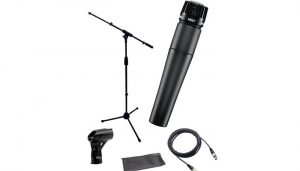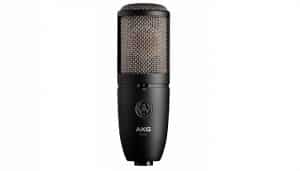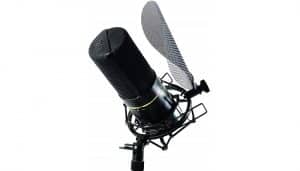The 3 Best Recording Microphones
If you are planning on building your own recording studio at home, or maybe you just want to record vocals for a new song, surely you are on the look for the best microphone to record. Here we present to you a selection of the Best Recording Microphones that are leading the market.
You may have noticed that there are many brands and models which make choosing one microphone really difficult. All the brands and models offer different characteristics, strengths and weaknesses that simply saturate you with information. That is why we have created an article that will provide you with all the necessary information about this type of microphones, as well as our list of favorites.
Our choices are based on research done to the preferences of the experts, the advantageous or not characteristics of each of the options, and the opinions of the users. We narrowed the selection down to a list of 3 recording microphones, which meet the demands and are not that expensive.
- Comparison chart of the 3 Best Recording Microphones
- What Are Voice Recording Microphones?
- Why Buy Voice Recording Microphones?
- Important points I should know before buying recording microphones of any brand or model
- Which Recording Microphone Should I Buy?
- Conclusion
- Comparison chart of the 3 Best Recording Microphones
Comparison chart of the 3 Best Recording Microphones
1.- Shure SM57-LC Dynamic Microphone
 The Shure SM57-LC Dynamic Microphone is used by musicians around the world, and if you want the best, look no further. This microphone is widely used by numerous famous singers spanning all kinds of different genres.
The Shure SM57-LC Dynamic Microphone is used by musicians around the world, and if you want the best, look no further. This microphone is widely used by numerous famous singers spanning all kinds of different genres.
This model offers a very high maximum SPL, which means you can easily use it for various other instruments, and even for drums. In terms of performance, most of the positive feedback comes from the male vocal community, as this model can handle the minima surprisingly well. It even compares it to similarly priced condenser microphones and easily beat them.
Controls include bass reduction as well as boost and midrange presence control. It is exactly this and the high quality electronics that makes it so versatile and easy to use. This model comes with Stand, windscreen and 6 meter XLR cable.
Buying Guide for the Shure SM57-LC Dynamic Microphone
If you trust only music professionals, and want only high-quality equipment for your studio, the Shure SM7B is the one for you.
Price-quality ratio
Good value for the money. Its price is according to the value it offers. And trust us when we tell you that it is very valuable.
Highlighting Features
It is very durable, with a robust design, great sound quality and its quite high SPL make it a creditor of our first selection.
Technical specifications
Where to Buy the Shure SM57-LC Dynamic Microphone?
We got the Shure SM57-LC Dynamic Microphone from Amazon.
2.- AKG P420 Recording Microphone

If you have a somewhat short budget to spend it all on a Shure microphone, but want to get the highest quality possible with little money, the go to microphone is the AKG P420. A great brand with very good technology applied to this equipment.
AKG is praised as one of the best audio brands on the market. The P420 is relatively inexpensive, but it guarantees excellent performance. What makes this model unique is its ability to switch between various polar patterns. The P420 offers cardioid, omnidirectional, and 8-shaped patterns.
Depending on the occasion, you can easily switch to a suitable preset. Use the omnidirectional pattern to record multiple people at once, or to experiment with various microphone settings and positions. Since it offers a maximum SPL of 155dB, you can count on the P420 to deliver recordings that sound warm and natural, regardless of the singing style or genre you’re working with.
With enough time spent finding the right position, you can even use multiple P420s for some great ambient sound recordings, if that's what you're looking for. Perfect for much more than studio recording, this model will easily replace any microphone you need for other occasions, such as podcast recording or casual PC use. Speaking of PC, you may also be interested in the list of Microphones for PC that we have on our page.
Buying Guide For AKG P420 Recording Microphones
There are very few better microphones than the AKG P420 Multi-Pattern Condenser Microphone, both in its price range and features.
Price-quality ratio
Great value for the price. You won't get any better at that price.
Highlighting Features
Its alternation between several patterns, together with its sale price makes it a great acquisition.
Technical specifications
Where to buy AKG P420 recording microphones?
We got the AKG P420 Recording Microphone from Amazon.
- Micrófono AKG PERCEPTION-420 profesional de uso general
- Condensador de doble diafragma de una pulgada
- Cuerpo metálico robusto con rejilla de acero
- Patrón conmutable: Cardioide omnidireccional y figura octogonal
- Filtro de bajos conmutable
3.- MXL 770 Recording Microphone

Don't let the price tag fool you. This microphone has a great value and is perfect for beginners on a smaller budget. One of the cheapest models on our small list, the MXL 770 is quite possibly the best budget voice recording microphone you can get.
The kit comes with the microphone itself, a stand, as well as a sturdy storage / carries case. It's really hard for you to get a microphone in this price range that offers all of that.
The build quality of this model is surprisingly good. An all-metal construction not only gives it a nice, heavy feel, but it can also resist shock. From that point of view, it will last a long time if you take good care of it.
The upper end of the range benefits female voices as it transmits high notes in a very natural way. The lower end is not far behind. It really shines when used to record genres like rap or R&B. Depending on the equalizer settings, it can sound quite warm and balanced.
The MXL 770 is also very useful for recording instruments. You can use it for anything from an acoustic guitar to drums.
Buying Guide for the MXL 770 Recording Microphone
The MXL 770 is an inexpensive microphone that beginners, advanced musicians and studio technicians alike, will appreciate. If you're looking for a versatile microphone that you can use for more than just recording vocals, definitely consider getting this one.
Price-quality ratio
There is a good quality price relation. It is a very good microphone at a relatively low price.
Highlighting Features
Since this is a condenser microphone, you can expect a lot of detail. Since it offers a nice and wide frequency response range, it is quite versatile in several different genres.
Technical specifications
Where to buy the MXL 770 recording microphones?
We got the MXL 770 Recording Microphone from Amazon.
- Con diafragma pequeño, cálido sonido con una claridad adicional en el extremo superior
- Utiliza un preamplificador FET de alta calidad con salida balanceada para un amplio rango dinámico
- Excelente para las voces, pianos y cuerdas
- Ideal para la grabación de hip-hop y el rock duro
What Are Voice Recording Microphones?
A recording microphone performs the same function of any microphone. It catches the sound to increase it or execute it with other characteristics. The main detail that differentiates a voice recording microphone from the rest is its ability to record all the nuances of the voice, without altering them. They are specifically designed to pick up the voice.
Why Buy Voice Recording Microphones?
These microphones will give you great sound quality, and will not disturb the voice. These microphones are designed to catch something as complex as the sound of the human voice without losing quality or nuances, and enhancing its shine and shape. In reality they are an investment that every musician knows to do without regrets.
Important points I should know before buying recording microphones of any brand or model
You may have several different microphones out there, but which one should you use? While you could technically use almost any microphone for vocal recording, to achieve the best possible results, you should consider the following.
Diaphragm type. Dynamic, Capacitor And Ribbon
Starting with the basics, there are three main types of microphones you can get.
Dynamic Microphone
The main advantage of this type of microphones is that they are generally better able to handle sound at higher volume levels. They also perform better in terms of noise rejection. Dynamic microphones work by vibrating a rigid diaphragm wrapped in a cable.
Interruptions in the magnetic field induce the electrical audio signal. The thick diaphragm is strong and can withstand noisy sound sources. It also vibrates less and produces a clean, colorless, but not sensitive sound. In the studio, dynamic microphones are used in noisy sources such as kicks, snares, drums, and amps.
Condenser microphone
Condenser microphones, on the other hand, can pick up more audio detail, but unlike dynamic ones, they don't work as well with loud sounds. Condenser microphones work by vibrating a charged metal plate. The voltage differences between the movable faceplate and the secondary charged stationary board create the audio signal which is then amplified.
Since an initial current is required to polarize the plates and amplify the signal, condenser microphones require phantom power (+ 48v) or their own power supply.
Condenser capsules vary in size and are often separated into "large diaphragm" and "small diaphragm". Small diaphragms have less mass, can respond faster, and generally have a more responsive, bright, and natural sound. The heavier large diaphragms have a wider, warmer and smoother sound. Condenser microphones are more sensitive than dynamic microphones and respond well to acoustic instruments, clean amps, vocals, and drum overload.
Don't forget that condenser microphones require additional "phantom" power to function. This means that you will need to make sure that the devices you plan to use the microphone on offer this feature.
Condenser microphones also tend to be slightly more expensive, which is especially important if you're on a tight budget. While we can go into more detail about the differences between these two types, this amount of information is enough.
Ribbon Microphones
Ribbon microphones work by vibrating a very thin aluminum ribbon between two strong magnets. The relatively low induced signal is then run through a dedicated transformer to boost the signal. These fragile and thin diaphragms are very sensitive and can vibrate a lot, creating a wide, nuanced, dark, soft and warm sound. In the studio, ribbon microphones are used in moderate-level amplifiers, strings, vocals, brass, acoustic instruments, drum ceilings, and as room microphones.
Frequency response
If you have ever dealt with audio equipment, you are probably familiar with the concept of frequency response. Like headphones and the frequency range in which they are capable of producing sound, microphones have a range of frequencies that they can pick up.
In most cases, you want a microphone with as a flat frequency response graph as possible. This means that minima, middle and maxima are detected and processed equally, with no part of the spectrum getting an extra boost or lagging behind.
However, certain occasions require slightly different performance. Bass rich voices will be easier to record with a microphone that offers good low level response. The same applies to higher pitched voices. You're just looking at the other end of the spectrum.
The overall frequency response that most microphones offer is around 20Hz - 20kHz, so you can use that as a baseline.
Different types of polar pattern
Since sound is basically a wave that mainly spreads evenly through the air, the way a microphone picks up those waves and the angle at which it does so is an important consideration.
The polar pattern of a microphone describes the sensitivity to which it receives sound from various angles. Cardioid microphones capture sound coming from the front, while "rejecting" any sound coming from other directions. They are most commonly used to record vocals, simply because the sound comes from a single angle.
Other types of polar patterns include omnidirectional patterns, which focus on more than one sound source. This can be useful if you plan to record many people at once, be it a choir or supporting vocals that have multiple people involved.
Sound Pressure Level (SPL)
SPL, or sound pressure level, describes the highest volume level of input sound that the microphone can pick up without distorting the signal and starting to lose quality. Unless you plan to record aggressive and brutal vocals, this factor may not play a role, but having a versatile microphone in terms of SPL is a good idea.
Most good microphones have a toggle that toggles sensitivity and maximum SPL, so you can adjust it according to the occasion. This means that you can practically use a microphone for various situations, from voice recording to other instruments as well. So if you're on a tight budget, saving for a microphone with attenuation pads is usually a better idea than buying two or more microphones to record vocals, guitar, or drums, since you can cover all of that with a single device.
Pop filter
A pop-up filter is the "windshield" that is placed between the voice and the microphone. Although it is a very important equipment to have, it is sad that many musicians forget to use it or simply do not understand how necessary it is.
By using a pop filter, you block out unwanted air reaching the microphone when a person sings certain sounds and syllables. Those pops of sound are usually very noticeable, and lead to clipping of the signal, which can be very difficult or impossible to eliminate when you start mixing the tracks.
While many microphones come with a pop filter included, their actual quality can vary greatly. So your best bet is to spend a little extra money and get yourself a suitable one.
Which Recording Microphone Should I Buy?
As with other pieces of musical equipment, price often dictates quality. While you can get a decent microphone to record vocals for little money, it's important that you're aware of the specs and features that may be crucial to your exact needs.
As we've already said, sometimes it's better to wait, save more money, and get a microphone that offers a higher level of versatility and can be used for more than just recording vocals.
The best versatile mid-range microphone is the AKG P420. The fact that the P420 offers switchable polar patterns makes it amazing for recording individual voices as well as multiple people. And its price is incredible.
The best in general terms is the Shure SM7B which is our main recommendation.
Conclusion
So we've had a chance to review some of the best microphones for recording vocals. At the end of the day, it's really up to you to and the features and specifications that you consider most important to adapt to your needs and choose accordingly. We are glad that you found this informative article and we hope that it has helped you to choose the right vocal recording microphone for you. Thanks for reading.
Comparison chart of the 3 Best Recording Microphones
Última actualización el 2024-07-27 / Enlaces de afiliados / Imágenes de la API para Afiliados
Si quieres conocer otros artículos parecidos a The 3 Best Recording Microphones puedes visitar la categoría Types.
Leave a Reply




¡Más Contenido!